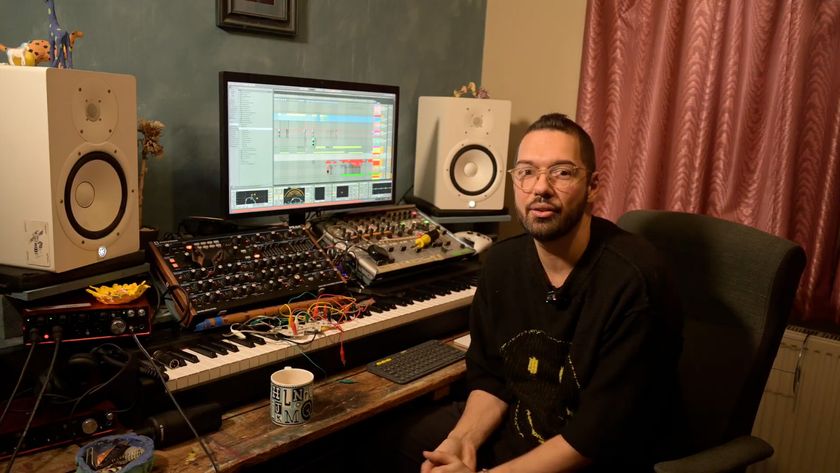Dusty Kid: "I worry about maintaining vintage gear... I think I’ve spent more time dealing with it than playing with it"
The Italian producer and DJ tells us why a clearout was key to creating a more streamlined setup

Sardinian-born DJ and producer Dusty Kid – aka Paolo Alberto Lodde – has been at the forefront of the more intricate side of electronic music production for more than 15 years.
Influenced by legendary names like Jam & Spoon, Jeff Mills and Daft Punk, his early output came to the attention of some legendary DJs, and he ended up on the set lists of Richie Hawtin and Sven Väth among many others.
He went on to release tracks on many cutting-edge labels, including Bpitch Control, Boxer Recordings and Fatboy Slim’s Southern Fried, including his classic 2009 album, A Raver’s Diary which was re-released this year on double vinyl. Tracks like Lynchesque and Sysma have notched up millions of view on YouTube which has helped Lodde become a prolific remixer, and he has now reworked tracks by everyone from Pet Shop Boys to Moby.
His current output varies from upbeat pop to more melodic techno, a diverse range of styles helped undoubtedly by an upbringing that saw him exposed to so many different types of music. “I’ve been surrounded by music, ever since I was a child,” he confirms. “I always loved what my parents were listening to, from classical music to psychedelic rock from the '60s and '70s.”
This influence led Paolo to start making music at just four years old. The inevitable music education followed… and rite-of-passage rejection of it in favour of production. “I took piano and violin lessons until I was 14 but gave it up as I had more of a passion for composition than playing other people’s music. I got into music production with very basic equipment and imitated what I considered to be ‘techno’ at the time (things like Ace Of Base’s ‘All That She Wants’) [laughs].”
The equipment might have been basic, but its limitations certainly helped Lodde get a good grounding in music production. “I was making music with a Korg workstation with a sampler, a built-in mixer and nothing else,” he recalls. “You could sequence stuff easily on the keyboard with a maximum of 128k notes, if I recall correctly, and it was pretty easy to run out. Then a friend of mine introduced me to Acid from Sonic Foundry, which was revolutionary to me, as you could work directly with audio files instead of MIDI, so I started recording the MIDI sequences in audio and sequenced them into Acid. At the end, it was a bit frustrating because I was so used to working with the MIDI so I needed something that included that as well; then I discovered Cubase VST. I think that was around 1999.”
Cubase VST was a game changer in many ways, as it was one of the first DAWs to introduce the concept of virtual instruments, and it was certainly a game-changer for Lodde.
Get the MusicRadar Newsletter
Want all the hottest music and gear news, reviews, deals, features and more, direct to your inbox? Sign up here.
“Yes, completely,” he agrees. “Back in the '90s, unless you had a lot of money to buy equipment and run a studio - and most importantly, the necessary knowledge to make it work properly - there weren’t many options to produce electronic music in other ways, especially because sampling was at the core of it and samplers had so little memory; kilobytes or megabytes if you were lucky! You had to deal with it by downsampling and so on, and they were so expensive. So making everything inside a computer was truly revolutionary as it gave a lot of people the chance to make music spending only a few bucks on software. Today, with a laptop and a DAW you can, of course, make great music wherever you are.”
The Dusty tech
Since the early days of Acid and Cubase VST, Paolo has clearly upped his game and his studio gear, and it’s now a happy balance of cutting-edge hardware and software.
“I have a Mac Pro running Logic Pro X, with a Universal Audio Apollo 8 and a Solid State Logic Nucleus,” he says, but adds that this more streamlined - and exceptionally neat - setup has come about thanks to a pretty ruthless approach when it comes to getting rid of plugins, and classic gear.
“I recently cleaned up the computer and got rid of a lot of plugins that I don’t use,” he states. “In general I tend to use Logic stock plugins which are very good, some Soundtoys, Valhalla, Roland Cloud plugins and not much more. I have tons of UAD plugins that I don’t use even if I think they are good, but the fact that they cannot run on my laptop when I’m on the road is frustrating and means I use them less and less.
"I still have some hardware synthesisers but I also got rid of most of them as well – a Memorymoog, Minimoogs, Synthi and an ARP 2600. I have to admit that I don’t really look back and miss them. I have just kept those that I felt a deep connection with, both their sound and interface.”
We wonder whether that spells the end of the road for classic hardware for Dusty Kid? “The only thing I would like to buy some day is the Oberheim OB-8,” he replies, but adds: “I do worry about maintaining vintage gear. I’ve had so many problems in the past with it that I think I’ve spent more time dealing with it than playing with it, and that’s one of the main reasons I got rid of most of it. The ones that never gave me problems are the Rolands, so I kept the Jupiter-6, SH-101 and the Juno - very well built, I’ve never had to deal with technicians, and they always work flawlessly. Oh, and the DX7. I love its sound and mine still really looks like it’s 1982!”
So now the Dusty setup is a great blend of hardware and software, both old and new - and Paolo does also yearn for one combination of the two that hasn’t been invented quite yet.
“One thing that is very obvious and logical that nobody has really made yet is a virtual synth plugin with its own hardware controller that makes it like you are playing and tweaking hardware. I’d pay a lot of money to see a software Jupiter 6/8 with the hardware controller looking like the real deal. The Access Virus TI was a great idea when it got introduced years ago, but its menu diving always drove me crazy. There are some other options and I tried them all, but never found them as good as I thought they’d be.”
Varied Dusty methods
Nowadays, Paolo’s output can vary from all of those remixes to different styles of solo and collaborative music, so as you might expect there isn’t one stock way that he goes about producing a track.
“It really depends,” he agrees. “I don’t have a proper formula. Normally I’d play something on the piano and once I come up with an interesting melody or chords, I start building drums around it and then I let it go. But I have to say, most of the time I never come to finish a track unless feeling very inspired; I have millions of sketches with good melodies and such, but if I cannot get it sounding good from the very first hour I usually put it aside and start something else. I guess the most important thing is to approach music with passion and spontaneity. Sometimes it gets harder with pressure, so maintaining that philosophy plays a key role for achieving good results.”
There have also been many Dusty Kid collaborations over the years, with more planned (including one with Freedom Fighters, who have remixed various Dusty Kid tracks), and it’s these collaborations which have led to more studio knowledge for Paolo, which he then takes to the extreme.
“Most of the ‘tricks’ I use are basically learned from other people,” he admits. “For instance, I am obsessed by the sidechain and the parallel compression process, and I use it in every single channel of a song. Depending on the material it could be very light or hard, and sometimes I end up with very complex signal chains in the project, so much so that if I leave the project for a while and then come back to it, I struggle to remember all the connections so end up closing it again!”
And yet another more recent collaboration has led to Dusty using more referencing in his productions: “I am working on a side pop project with a young talented guy from my home town and have started using some references when mixing. I hadn’t done this until only a few months ago, and it really helps a lot.”
Industry guru
Paolo has also learned some other hard lessons from his two decades in the industry. The first is that sometimes you have to do what is expected: “The music industry is a very complex mechanism and not always easy to surf,” he explains. “I always let my heart decide what music to make but you have to keep in mind that people’s expectations are there and you have to deal with it.”
And the second is far more practical, and perhaps about reducing expectations…
“I always wanted to play live with machines and interact with them more spontaneously than working with audio and MIDI clips on Ableton Live, but from travelling a lot, I’ve learned that dealing with airlines can pretty easily turn everything involved into a nightmare. I have now come to the realisation that performing live is only really an option for me if all of the equipment can fit into just my carry-on luggage!”
A Raver’s Diary has become something of a classic Dusty Kid album, with tracks notching up hundreds of thousands of YouTube views. It has become such an iconic recording that the decision was made to rerelease it earlier this year, with further plans to back up the release.
“There is a plan for the anniversary release of it to play the entire album live,” Kid explains. “I’ve seen Massive Attack doing it with Mezzanine and I enjoyed every single second of the show, so maybe people who loved Raver’s Diary could enjoy the whole album live - who knows?”
With that tantalising prospect put out there for fans, it just remains for to ask what else Paolo has in the works?
“I am currently working on a new album and I am very excited,” he replies. “It has tons of '90s influences and a soundtrack feeling. It will probably be part of a project that I’ve been thinking about and planning for years. I’ve also been working on some new music especially for the dancefloor.”
The re-released album A Raver’s Diary is out now on Boxer Recordings.


Computer Music magazine is the world’s best selling publication dedicated solely to making great music with your Mac or PC computer. Each issue it brings its lucky readers the best in cutting-edge tutorials, need-to-know, expert software reviews and even all the tools you actually need to make great music today, courtesy of our legendary CM Plugin Suite.

“My love letter to a vanished era that shaped not just my career but my identity”: Mark Ronson’s new memoir lifts the lid on his DJing career in '90s New York

“I'm always starting up sessions and not finishing them, but I don't see that as unproductive”: Virtuosic UK producer Djrum talks creativity and making Frekm Pt.2










